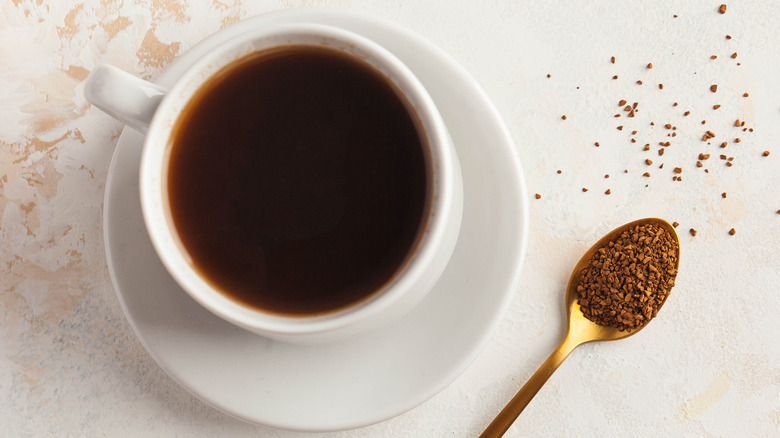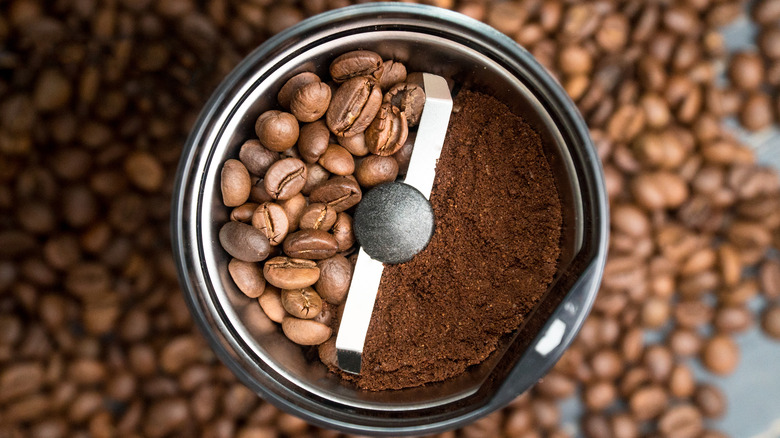What Instant Coffee Is Actually Made Of
Coffee drinkers that swear by ground beans and fresh espresso with thick crema may look at instant coffee with disdain. Some enthusiasts think instant grounds make watery brews, can have a sour aftertaste, and simply don't pack the punch that ground coffee does in the morning. Many javaphiles wouldn't touch instant coffee with a 10-foot pole, but its affordability and convenience is the reason why it still holds much sway — even global coffee chains like Starbucks offer instant coffee products alongside their ground beans.
Much has been spoken in favor of (or against) instant coffee, but what is it really? More importantly, what makes instant options so different from regular ground coffee and why is it often considered subpar in comparison? Believe it or not, instant coffee is simply made from freshly brewed java. Instant types are made from roasted coffee beans that have been ground and brewed into a concentrated batch. But here's where things change: The brew is then dehydrated until all the liquid is gone, leaving only dry granules of coffee that can then be dissolved in water, rehydrated, and turned into a cup of coffee once again.
How instant coffee has been created throughout history
Instant coffee may seem like a relatively new invention born in the age of convenience (like TV dinners), but it happens to be a fairly old way of drinking coffee — in fact, the first record of a coffee powder that dissolved in water dates back to 1771. Back then, London resident John Dring filed a patent for his instant coffee, which was made by mixing roasted, ground coffee with butter and suet into a paste with the occasional addition of vanilla, cinnamon, and musk for flavoring.
This coffee paste then turned into a powder sometime around 1861 when coffee, sugar, and evaporated milk were dehydrated into a convenient one-and-all drink for the American military. But it wasn't until 1889 that a commercial version resembling the instant coffee that we know today was born — New Zealander David Strang used a patented device that made instant coffee by blowing hot air over the brewed java until it dehydrated into a powder.
Modern methods of creating instant coffee look a little different. While it's standardly made by dehydrating brewed coffee into a powder, there are other ways to go about it. Brewed coffee can either be spray-dried (where a liquid is sprayed into air so hot that it dries the droplets into dehydrated granules in a flash), or it can be freeze-dried, which is a slightly longer process. For the latter, a concentration of brewed coffee is frozen into ice, broken into small fragments, and vacuum-dried until the ice evaporates, leaving a fine powder of instant coffee in its wake.
Instant coffee vs ground coffee
The most obvious difference between instant coffee and ground coffee is how each one is first made and brewed, and the fact that one dissolves but the other doesn't. While ground coffee is made by roasting and grinding beans into a size that is customized for your brewing equipment — espresso machine, French press, and the like — instant coffee simply needs a splash of water to turn into a steaming hot cup of java.
There are, however, more nuanced differences between the two. For one, the dehydration process strips much of the caffeine from instant coffee: Where one cup of joe made from a teaspoon of instant coffee powder will contain 30-90 mg of caffeine, the same cup brewed from ground coffee will have 70-140 mg.
Despite its affordability, quick convenience, and long shelf-life, instant coffee is often considered inferior in flavor as well. Instant coffee is almost always made from more affordable robusta beans. While robusta beans have more caffeine, they have less fat and sugar than arabica beans (the status quo for ground coffee), which gives them a more bitter and earthy flavor. The heat from spray drying these beans also results in a loss of flavor and aroma. But because the process is cheaper than freeze-drying, some manufacturers stick to the former method and use additional chemicals to mask the results, which means there's often more than just dehydrated java lurking in instant coffee powder.



